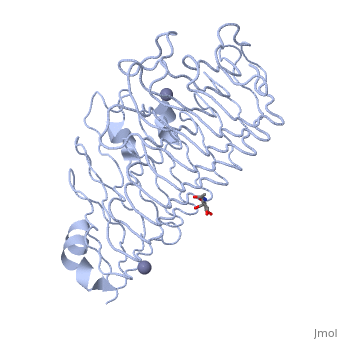Polygalacturonase: Difference between revisions
Krishna Amin (talk | contribs) No edit summary |
Krishna Amin (talk | contribs) No edit summary |
||
| Line 9: | Line 9: | ||
== Structural highlights == | == Structural highlights == | ||
The secondary structure of PGs is comprised of a ten turn right handed beta helix domain along with two loop regions that together form the substrate-binding cleft, which appears to have a tunnel-like shape. The active site of PGs is found between the two looped regions of the protein. Located within the looped regions are two conserved aspartate residues that are predicted to participate in catalytic activity. | |||
</StructureSection> | </StructureSection> | ||
== References == | == References == | ||
<references/> | <references/> | ||
Revision as of 21:36, 12 July 2017
|
Polygalacturonases (PGs) catalyze the enzymatic depolymerization of pectins – polysaccharides that comprise the plant cell wall. Polymer disassembly of substrates by exo- and endo- PGs is carried out via a hydrolytic mechanism. Degradation of pectins in plant cell walls contributes to ripening of fruits, such as tomatoes and melons (Polygalacturonases: many genes in search of a function).
FunctionFunction
PGs cleave α-(1-4) – glycosidic bonds between consecutive galacturonic acid residues.
DiseaseDisease
RelevanceRelevance
Structural highlightsStructural highlights
The secondary structure of PGs is comprised of a ten turn right handed beta helix domain along with two loop regions that together form the substrate-binding cleft, which appears to have a tunnel-like shape. The active site of PGs is found between the two looped regions of the protein. Located within the looped regions are two conserved aspartate residues that are predicted to participate in catalytic activity.
</StructureSection>
